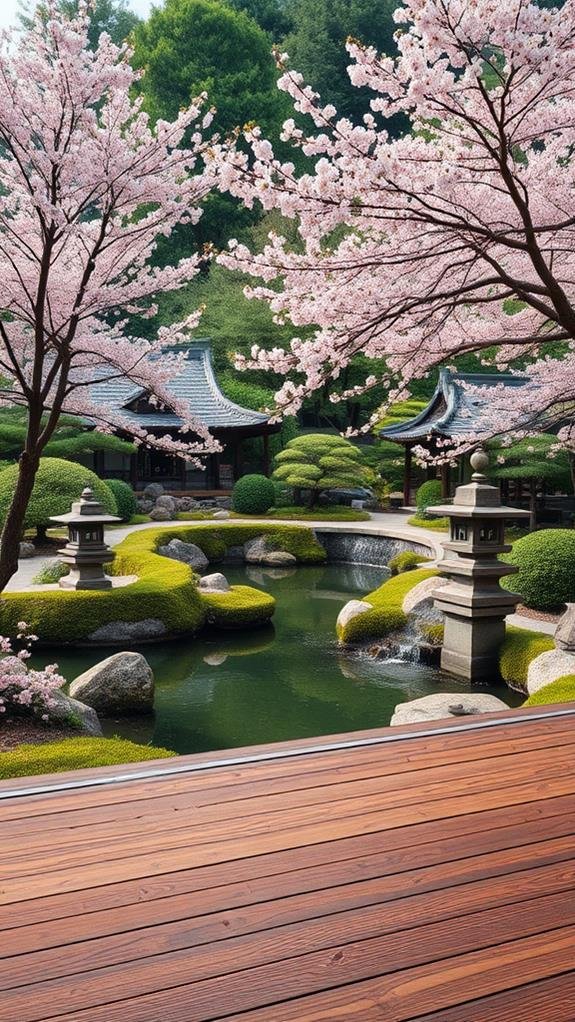What Are Key Principles of Japanese Interior Design?
You might find yourself intrigued by the key principles of Japanese interior design, where simplicity and harmony take center stage. It’s not just about aesthetics; it’s about creating a tranquil environment that fosters a connection to nature. With elements like clean lines and natural materials, these spaces evoke a sense of calm. However, there’s more to investigate regarding how these principles not only shape homes but also influence our well-being and lifestyle choices. Let’s uncover what defines this minimalist approach and its broader implications.
Emphasis on Simplicity

In Japanese interior design, simplicity speaks volumes through every element you encounter.
You’ll notice that rooms often have clean lines and uncluttered spaces, creating a sense of calm.
This minimalist approach isn’t just about fewer items; it’s about thoughtfully selecting pieces that serve a purpose and bring harmony. For example, a single, beautiful vase can stand out in a space, drawing your attention without overwhelming you.
You’ll also find muted colors that promote tranquility, allowing the beauty of each element to shine.
Lighting plays an essential role too, as natural light is cherished and used to highlight simplicity.
Use of Natural Materials

Embracing natural materials is at the heart of Japanese interior design, creating spaces that feel grounded and connected to nature.
You’ll notice that wood, bamboo, stone, and rice paper are commonly used, giving each room a warm, inviting atmosphere. Pine, cedar, and cherry wood are especially popular because of their beauty and durability.
By using these materials, you not only improve the aesthetic appeal but also promote a sense of tranquility and balance. Textures play an essential role too; smooth surfaces, rough stones, and soft fabrics can all coexist to create harmony.
When you choose natural materials, you align your space with a philosophy that values simplicity and authenticity, allowing your home to feel both cozy and balanced.
Harmony With Nature

Harmony with nature is essential in Japanese interior design, seamlessly blending indoor and outdoor environments.
You’ll often find large windows that invite natural light and beautiful views inside, creating a peaceful atmosphere. Natural elements like plants, water features, and even stone are integrated into living spaces, allowing you to feel connected to nature while indoors.
This design approach encourages tranquility and balance, making your home a serene retreat. Sliding doors, known as shoji, are used to open up spaces, letting fresh air circulate.
When decorating, consider using colors inspired by nature—soft greens, browns, and blues—creating a calm and soothing environment. Embracing harmony with nature not only improves your space but also promotes a feeling of overall well-being.
Minimalistic Aesthetics

Minimalistic aesthetics are a defining feature of Japanese interior design, focusing on simplicity and functionality. In your home, you might notice how this style encourages you to declutter, letting only essential items shine.
Think of clean lines and open spaces that create a calm atmosphere. Instead of filling your rooms with many decorations, you’ll adopt natural materials, like wood and paper, which add warmth without overwhelming the senses.
Soft, muted colors can improve this soothing vibe, inviting relaxation. When you embrace minimalism, you’re not just saving space; you’re also promoting a more mindful way of living.
Balanced Space and Function

In traditional Japanese interior design, achieving a balanced space and function has always been essential. This concept focuses on creating environments that serve their purpose while also feeling harmonious.
You’ll notice that spaces are often carefully arranged to allow for smooth movement and effective use. For instance, sliding doors, known as shoji, let you separate areas or blend them seamlessly, adapting to your needs.
Using natural materials, like wood and rice paper, improves this balance by adding warmth and tranquility.
Think about how light filters through these materials, creating a peaceful atmosphere. By thoughtfully selecting furniture and decor, you can maximize both function and aesthetic appeal, ensuring every element within the space contributes to an overall sense of balance and purpose.
Conclusion
In summary, Japanese interior design isn’t just about looks; it’s about creating a peaceful and balanced environment. By focusing on simplicity, using natural materials, and harmonizing with nature, you can transform any space into a serene retreat. The minimalistic approach emphasizes clarity and functionality, allowing you to enjoy your surroundings without clutter. So, whether you’re redecorating a room or just looking for inspiration, remember these principles to create your own tranquil haven at home.

